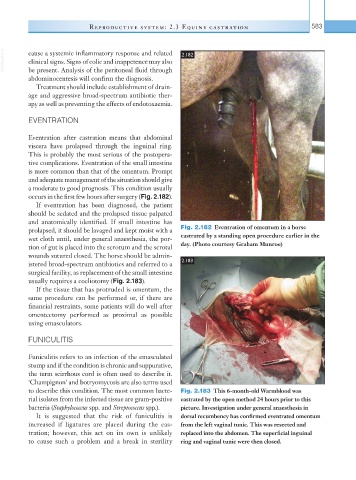Page 608 - Equine Clinical Medicine, Surgery and Reproduction, 2nd Edition
P. 608
Reproductive system: 2.3 Equine castr ation 583
VetBooks.ir cause a systemic inflammatory response and related 2.182
clinical signs. Signs of colic and inappetence may also
be present. Analysis of the peritoneal fluid through
abdominocentesis will confirm the diagnosis.
Treatment should include establishment of drain-
age and aggressive broad-spectrum antibiotic ther-
apy as well as preventing the effects of endotoxaemia.
EVENTRATION
Eventration after castration means that abdominal
viscera have prolapsed through the inguinal ring.
This is probably the most serious of the postopera-
tive complications. Eventration of the small intestine
is more common than that of the omentum. Prompt
and adequate management of the situation should give
a moderate to good prognosis. This condition usually
occurs in the first few hours after surgery (Fig. 2.182).
If eventration has been diagnosed, the patient
should be sedated and the prolapsed tissue palpated
and anatomically identified. If small intestine has
prolapsed, it should be lavaged and kept moist with a Fig. 2.182 Eventration of omentum in a horse
wet cloth until, under general anaesthesia, the por- castrated by a standing open procedure earlier in the
tion of gut is placed into the scrotum and the scrotal day. (Photo courtesy Graham Munroe)
wounds sutured closed. The horse should be admin-
istered broad-spectrum antibiotics and referred to a 2.183
surgical facility, as replacement of the small intestine
usually requires a coeliotomy (Fig. 2.183).
If the tissue that has protruded is omentum, the
same procedure can be performed or, if there are
financial restraints, some patients will do well after
omentectomy performed as proximal as possible
using emasculators.
FUNICULITIS
Funiculitis refers to an infection of the emasculated
stump and if the condition is chronic and suppurative,
the term scirrhous cord is often used to describe it.
‘Champignon’ and botryomycosis are also terms used
to describe this condition. The most common bacte- Fig. 2.183 This 6-month-old Warmblood was
rial isolates from the infected tissue are gram-positive castrated by the open method 24 hours prior to this
bacteria (Staphylococcus spp. and Streptococcus spp.). picture. Investigation under general anaesthesia in
It is suggested that the risk of funiculitis is dorsal recumbency has confirmed eventrated omentum
increased if ligatures are placed during the cas- from the left vaginal tunic. This was resected and
tration; however, this act on its own is unlikely replaced into the abdomen. The superficial inguinal
to cause such a problem and a break in sterility ring and vaginal tunic were then closed.

